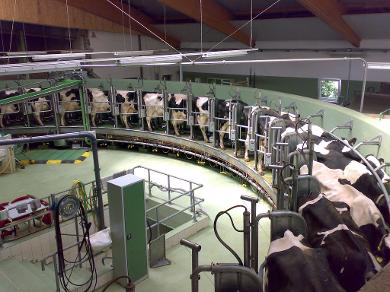Robotic Dairies
What are robotic Dairies..
Robotic milking is a voluntary milking system, which allows the cow to set her own milking schedule. Following an initial training period, cows are milked with limited human interaction. Each cow on a robotic milking dairy is fitted with an electronic tag which allows the robot to identify her. When a cow enters the robot, her ID tag is read and she receives a feed reward customized to her level of production, the robot then cleans her teats, attaches the milk cups, and begins the milking processes. When milking is complete, the cups disconnect as each quarter finishes milking and she exits the robot. Milking occurs throughout the day and night.

Well how does these Robotic Dairies work?
Please see the video of Lely Robotic Dairies to find out this information .
How does the innovation increase production within the industry?
The milking robot supplies cow-related information unobtainable in a conventional situation, thereby making it possible to manage animals at an individual level in today’s situation. Management by exception is the new challenge. The idea is that management should spend its valuable time concentrating on the cows requiring attention. Furthermore, the concept of the ‘Licence to produce’ is introduced focussing on sustainable dairy farming with respect to people, planet and profit. With the milking robot, it is possible to supply an individual cow with all her needs for an optimal health, production and well-being, without the extra labour. The basis of successful dairy farming is the healthy and happy individual cow. With these many factors being controlled, it allows for maximal production in the milk industry.
What changes/Barriers are there in regards to these milking systems?
- Across all companies selling robotic milking technology users felt that better technical support was needed. Users felt that service has not been fast enough and it was sometimes difficult to get in contact with the correct person. Users did report that as robots have become more common, and technicians gain more experience with the systems, support is improving. Learning to use the software and to interpret data from the robots were also reported as challenges for some users, though all companies currently selling robots offer training and support in working with software and data.
- The greatest barrier to adopting the technology was the purchase cost of the systems. Fear of mechanical failure and learning the new technology were also described as difficult challenges.
Resources:
http://www.dairy.edu.au/discoverdairy/Students/From-Farm-to-Plate/Dairy-Farming-in-Australia.aspx
https://www.msu.edu/~mdr/vol17no3/challenges.html